Fault Geometry and Slip Distribution of the 2023 Jishishan Earthquake Based on Sentinel-1A and ALOS-2 Data
Abstract
1. Introduction
2. Regional Tectonic Context
3. InSAR Coseismic Deformation Field
3.1. Image Data and Processing
3.1.1. Image Data
3.1.2. Data Processing
3.2. Results of Coseismic Deformation Analysis
4. Geodetic Inversion
4.1. Uniform Slip Inversion
4.2. Distributed Slip Inversion
5. Discussion
5.1. Comparison with Existing Coseismic Models
5.2. Analysis of Seismic Faults and Regional Tectonics
5.3. Evaluation of Regional Seismic Risk
6. Conclusions
Author Contributions
Funding
Data Availability Statement
Acknowledgments
Conflicts of Interest
References
- Lu, S.M.; Wu, Z.H.; Li, Z.C. Seismic structure characteristics of the 18 December 2023 MW 6.2 Jishishan earthquake, Gansu Province. Prog. Earthq. Sci. 2024, 54, 86–93. [Google Scholar]
- Liu, Z.J.; Han, B.G.; Nai, Y.H.; Li, Z.H.; Yu, C.; Song, C. Source parameters and slip distribution of the 2023 MW 6.0 Jishishan (Gansu, China) earthquake constrained by InSAR observations. Geomat. Inf. Sci. Wuhan Univ. 2025, 50, 344–355. [Google Scholar]
- Yang, Y.M.; Su, S.J. The 2023 Jishishan MS 6.2 earthquake in Gansu Province, China: A shallow strong earthquake with thrust-dominated components. Earthquake 2024, 44, 167–174. [Google Scholar]
- Yang, J.Y.; Wen, Y.M.; Xu, C.J. Seismogenic fault Structure of the 2023 Jishishan (Gansu) MS 6.2 earthquake revealed by InSAR observations. Geomat. Inf. Sci. Wuhan Univ. 2025, 50, 313–321. [Google Scholar]
- Yang, P.X.; Xlong, R.W.; Hu, C.Z. Preliminary analysis of the seismogenic tectonics for the 2023 Jishishan MS 6.2 earthquake in Gansu Province. Earthquake 2024, 44, 153–159. [Google Scholar]
- Wang, Y.S.; Zhao, B.; Ji, F. Preliminary insights into the hazards triggered by the 2023 Jishishan MS 6.2 earthquake in Gansu Province. J. Chengdu Univ. Technol. (Sci. Technol. Ed.) 2024, 51, 1–8. [Google Scholar]
- Fang, N.; Sun, K.; Huang, C.C.; Bai, C.Y.; Chen, Z.D.; Xie, L.; Yang, Z.; Xu, Y.H.; Xie, H.B.; Feng, G.C.; et al. Joint inversion of InSAR and seismic data for the kinematic rupture process of the 2023 MS 6.2 Jishishan Earthquake. Geomat. Inf. Sci. Wuhan Univ. 2025, 50, 333–343. [Google Scholar]
- Gao, J.N.; Zou, R.; Wang, J.X. Inversion of Coseismic Rupture Model and Deformation Time Series for the Jishishan, Gansu MS 6.2 Earthquake Using InSAR. J. Geod. Geodyn. 2025, 45, 177–183. [Google Scholar]
- Hua, S.B.; Xu, C.Y.; Zhou, J.C.; Xu, B.B.; Feng, W.P.; Zhang, Y.; Feng, L.H. Source characteristics and disaster mechanisms of the 2023 Gansu Jishishan MW 6.0 Earthquake. Chin. J. Geophys. 2024, 67, 2625–2636. [Google Scholar]
- Sun, Y.Q.; Qiu, X.P.; Chen, C.Y. GNSS and InSAR derived coseismic slip distribution of the 2023 Jishishan MS 6.2 earthquake. China Earthq. Eng. J. 2024, 46, 867–879. [Google Scholar]
- Wang, S.G.; Xu, G.Y.; Li, S.; Yang, T.; Shi, L.; Zhang, L.; Tang, F.T.; Fang, L.H. Analysis of earthquake sequence and seismogenic structure of the 2023 MS 6.2 Jishishan earthquake, Gansu Province, China. Acta Seismol. Sin. 2024, 46, 953–968. [Google Scholar]
- Zhang, W.T.; Ji, L.Y.; Chen, Y.X.; Liu, C.J.; Xu, J. Analysis of Crustal Deformation of the 2023 MS 6.2 Jishishan Earthquake in Gansu Province. Geomat. Inf. Sci. Wuhan Univ. 2025, 50, 391–403. [Google Scholar]
- Tian, X.; Zhang, Z. Bulk crustal properties in NE Tibet and their implications for deformation model. Gondwana Res. 2013, 24, 548–559. [Google Scholar] [CrossRef]
- Chen, J.F.; Lin, X.D.; He, X.S. Moment tensor inversion and seismogenic tectonics of the 2013 Minxian MS 6.6 earthquake in Gansu. China Earthq. Eng. J. 2013, 35, 425–431. [Google Scholar]
- Zheng, W.J.; Yuan, D.Y.; He, W.G. Geometric pattern and active tectonics in southeastern Gansu province, Discussion on seismogenic mechanism of the Minxian-Zhangxian MS 6.6 earthquake on July 22, 2013. Chin. J. Geophys. 2013, 56, 4058–4071. [Google Scholar]
- He, X.; Zhang, Y.; Shen, X.; Zhang, W.; Zhang, P.; Zhang, D. Examination of the repeatability of two MS 6.4 Menyuan earthquakes in Qilian-Haiyuan fault zone (NE Tibetan Plateau) based on source parameters. Phys. Earth Planet. Inter. 2020, 299, 106408. [Google Scholar] [CrossRef]
- Feng, W.P.; He, X.H.; Zhang, Y.P.; Fang, L.H. Seismic faults of the 2022 MW 6.6 Menyuan, Qinghai earthquake and their implication for the regional seismogenic structures. Chin Sci Bull. 2023, 68, 254–270. [Google Scholar] [CrossRef]
- Yang, J.Y.; Wen, Y.M.; Xu, C.J. The 21 May 2021 MS 6.4 Yangbi (Yunnan) earthquake: A shallow strike-slip event rupturing in a blind fault. Chin. J. Geophys. 2021, 64, 3101–3110. [Google Scholar]
- Yuan, D.Y.; Ge, W.P.; Chen, Z.W.; Li, C.Y.; Wang, Z.C.; Zhang, H.P.; Zhang, P.Z.; Zhang, D.W.; Zheng, W.J.; Craddock, W.H.; et al. The growth of northeastern Tibet and its relevance to large-scale continental geodynamics: A review of recent studies. Tectonics 2013, 32, 1358–1370. [Google Scholar] [CrossRef]
- Zhou, S.; Zhane, H.; Sun, Y. Numerical simulation of tectonic stress and strain rate fields in the northeastern margin of the Tibetan Plateau in association with major fault zones. Sci. China Earth Sci. 2023, 66, 2353–2367. [Google Scholar] [CrossRef]
- Yuan, D.Y. Tectonic Deformation Features and Space-time Evolution in Northeastern Margin of the Qinghai-Tibetan Plateau Since the Late Cenozoic Time; Institute of Geology, China Earthquake Administration: Beijing, China, 2003. [Google Scholar]
- Zhang, P.Z.; Zheng, D.W.; Yin, G.M. Discussion on late cenozoic growth and rise of northeastern margin of the Tibetan plateau. Quat. Sci. 2006, 26, 5–13. [Google Scholar]
- Li, Z.M.; Tian, Q.J.; Tu, H.W. Remote sensing characteristics of Lajishan fault. Plateau Earthq. Res. 2009, 21, 26–31. [Google Scholar]
- Yuan, D.Y.; Zhang, P.Z.; Lei, Z.S.; Liu, B.C.; Liu, X.L. A preliminary study on the new activity features of the Lajishan mountain fault zone in Qinghai Province. Earthq. Res. China 2005, 21, 93–102. [Google Scholar]
- Zhou, L.; Wang, Q.L.; Li, Z.J. The Study of Crustal Deformation on Western End of Lajishan Fault Based on GPS and Leveling Data. J. Geod. Geodyn. 2016, 36, 1056–1060. [Google Scholar]
- Li, Z.M.; Su, P.; Huang, S.T. Slip rates of the Riyue MT. fault at DeZhou segment since late pleistocene. Seismol. Geol. 2018, 40, 656–671. [Google Scholar]
- Teng, R.Z.; Jin, Y.Q.; Li, X.H.; Su, X.Z. Recent activity characteristics of the fault zone at northern edge of western QinLing MT. China Earthq. Eng. J. 1994, 16, 85–90. [Google Scholar]
- Richard, O.L.; Douglas, W.B.; Marin, K.C. Middle miocene reorganization of deformation along the northeastern Tibetan Plateau. Geology 2011, 39, 359–362. [Google Scholar]
- Werner, C.; Wegmüller, U.; Strozzi, T. Gamma SAR and interferometric processing software. In Proceedings of the ERS-ENVISAT Symposium, Gothenburg, Sweden, 16–20 October 2000. [Google Scholar]
- Farr, T.G.; Rosen, P.A.; Caro, E. The Shuttle Radar Topography Mission. Rev. Geophys. 2007, 45, RG2004. [Google Scholar] [CrossRef]
- Weiss, J.R.; Walters, R.J.; Morishita, Y. High-resolution Surface Velocities and Strain for Anatolia from Sentinel-1 InSAR and GNSS Data. Gephys. Res. Lett. 2020, 47, e2020GL087376. [Google Scholar] [CrossRef]
- Goldstein, R.M.; Werner, C.L. Radar interferogram filtering for geophysical applications. Gephys. Res. Lett. 1998, 25, 4035–4038. [Google Scholar] [CrossRef]
- Goldstein, R.M.; Zebker, H.A.; Werner, C.L. Satellite radar interferometry Two-dimensional phase unwrapping. Radio Sci. 1988, 23, 713–720. [Google Scholar] [CrossRef]
- Cavalie, O.; Doin, M.P.; Lasserre, C. Ground motion measurement in the Lake Mead area, Nevada, by differential synthetic aperture radar interferometry time series analysis Probing the lithosphere rheological structure. J. Geophys. Res. 2007, 112, B03403. [Google Scholar] [CrossRef]
- Okada, Y. Surface deformation due to shear and tensile faults in a half-space. Bull. Seismol. Soc. Am. 1985, 75, 1135–1154. [Google Scholar] [CrossRef]
- Lohman, R.B.; Simons, M. Some thoughts on the use of InSAR data to constrain models of surface deformation: Noise structure and data downsampling. Geochem. Geophys. Geosyst. 2005, 6, Q01007. [Google Scholar] [CrossRef]
- Steck, L.K.; Phillips, W.S.; Mackey, K.M. Seismic tomography of crustal P and S across Eurasia. Geophys. J. Int. 2009, 177, 81–92. [Google Scholar] [CrossRef]
- Feng, W.P.; Li, Z.H.; Elliott, J.R. The 2011 MW 6.8 Burma earthquake fault constraints provided by multiple SAR techniques. Geophys. J. Int. 2013, 195, 650–660. [Google Scholar] [CrossRef]
- Parsons, B.; Wright, T.; Rowe, P. The 1994 Sefidabeh (eastern Iran) earthquakes revisited: New evidence from satellite radar interferometry and carbonate dating about the growth of an active fold above a blind thrust fault. Geophys. J. Int. 2006, 164, 202–217. [Google Scholar] [CrossRef]
- Mai, P.M.; Beroza, G.C. A spatial random field model to characterize complexity in earthquake slip. J. Geophys. Res. Solid Earth 2002, 107, ESE-10. [Google Scholar] [CrossRef]
- Hiroo, K.; Luis, R. Source inversion of Wphase: Speeding up seismic tsunami warning. Geophys. J. Int. 2008, 175, 222–238. [Google Scholar]
- Lay, T.; Kanamori, H. An asperity model of large earthquake sequences. Earthq. Pred. Int. Rev. 1981, 4, 579–592. [Google Scholar]
- Wald, D.J.; Heaton, T.H. Spatial and temporal distribution of slip for the 1992 Landers, California, earthquake. Bull. Seismol. Soc. Am. 1994, 84, 668–691. [Google Scholar] [CrossRef]
- Field, E.H.; Dawson, T.E.; Felzer, K.R. Uniform California Earthquake Rupture Forecast, Version 2 (UCERF2). Bull. Seismol. Soc. Am. 2009, 99, 2053–2107. [Google Scholar] [CrossRef]
- Yuan, D.Y.; Zhang, P.Z.; Liu, B.C. Geometrical Imagery and Tectonic Transformation of Late Quaternary Active Tectonics in Northeastern Margin of Qinghai-Xizang Plateau. Acta Geol. Sin. Chin. Ed. 2004, 78, 270–278. [Google Scholar]
- Symithe, S.J.; Calais, E.; Haase, J.S. Coseismic slip distribution of the 2010 M 7.0 Haiti earthquake and resulting stress changes on regional faults. Bull. Seismol. Soc. Am. 2013, 103, 2326–2343. [Google Scholar] [CrossRef]
- Wang, J.J.; Xu, C.J.; Shen, W.B. The Coseismic Coulomb Stress Changes Induced by the 2010 Mw 6.9 Yushu Earthquake, China and Its Implication to Earthquake Hazards. Geomat. Inf. Sci. Wuhan Univ. 2012, 37, 1207–1211. [Google Scholar]
- Li, Q.; Li, C.T.; Zhao, B. Estimated seismic source parameters for 2020 Dingri Mw 5.6 earthquake in Xizang and study on the stress triggering. Chin. J. Geophys. 2024, 67, 172–188. [Google Scholar]
- Xu, G.Y.; Xu, X.W.; Yi, Y.N. Seismogemic structure of the 2022 Menyuan Mw6.6 earthquake, Qinghai Province constrained by InSAR and Gaofen-7 observation. Chin. J. Geophys. 2022, 65, 4704–4724. [Google Scholar]
- Wang, R.; Lorenzo Martín, F.; Roth, F. PSGRN/PSCMP-a new code for calculating co- and post-seismic deformation, geoid and gravity changes based on the viscoelastic-gravitational dislocation theory. Comput. Geosci. 2006, 32, 527–541. [Google Scholar] [CrossRef]
- Freed, A.M. Earthquake Triggering by Static, Dynamic, and Postseismic Stress Transfer. Annu. Rev. Earth Planet. Sci. 2005, 33, 335–367. [Google Scholar] [CrossRef]
- Harris, R.A.; Simpson, R.W. Suppression of large earthquakes by stress shadows A comparison of Coulomb and rate-and-state failure. J. Geophys. Res. Solid Earth 1998, 103, 24439–24451. [Google Scholar] [CrossRef]
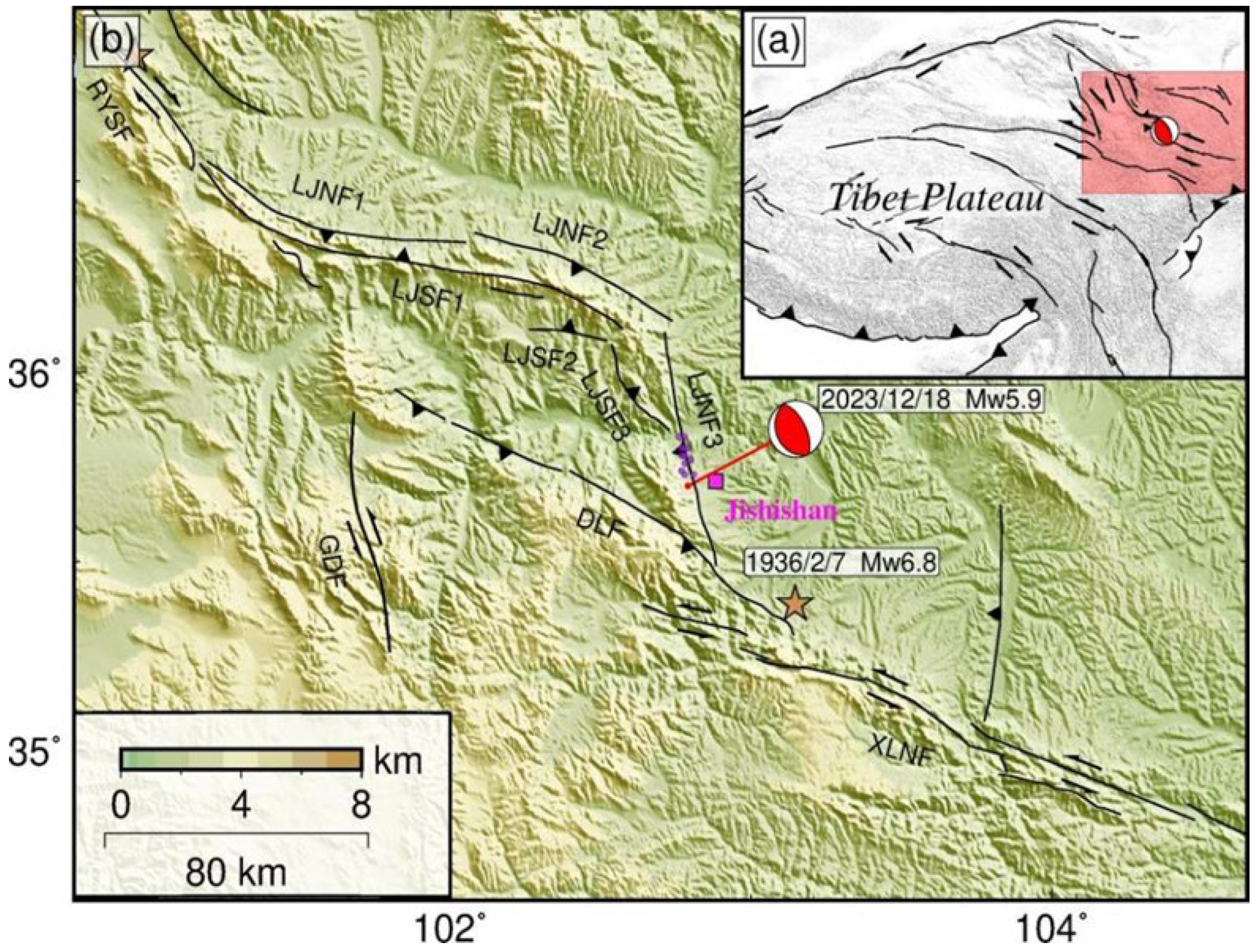


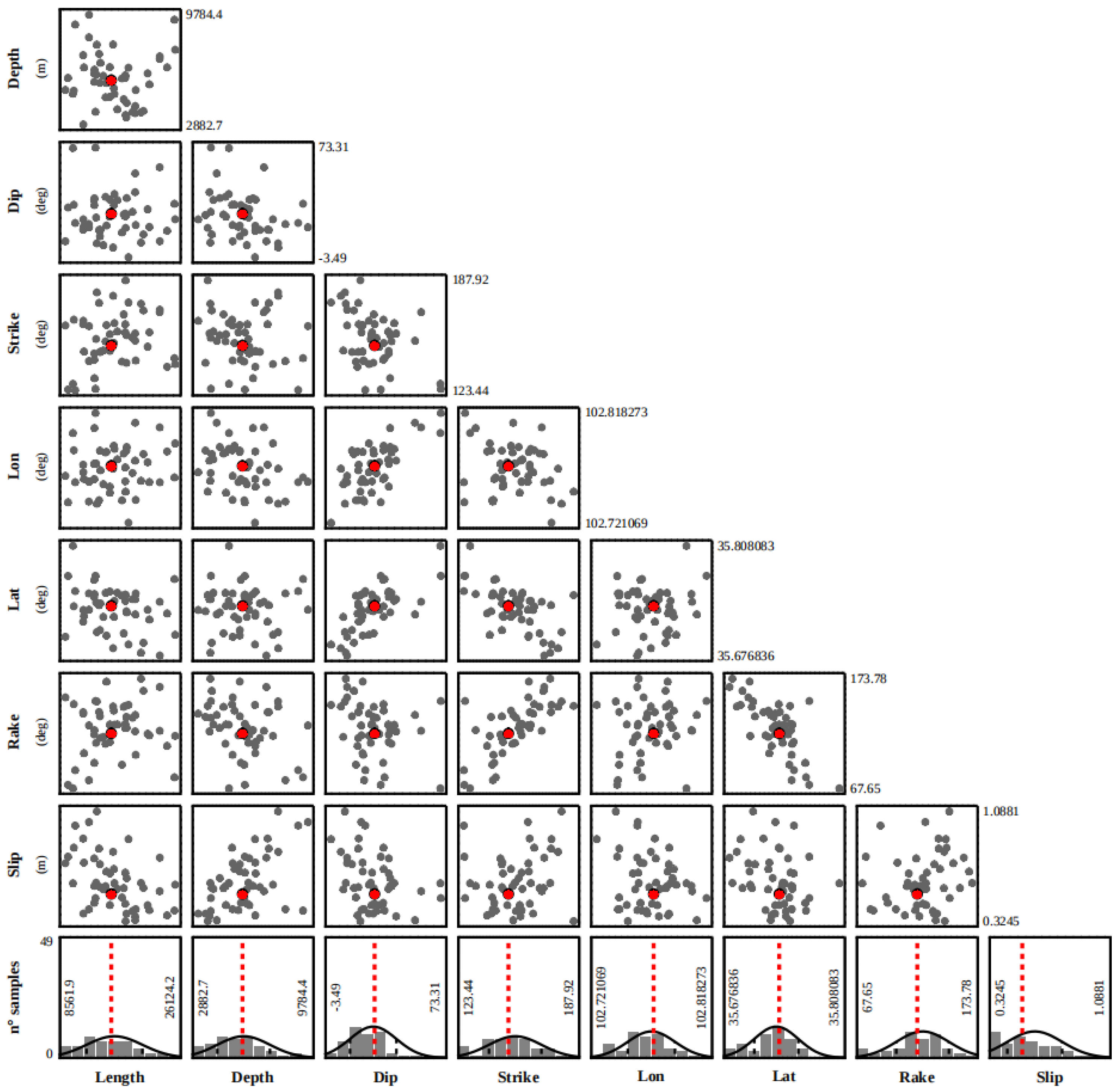
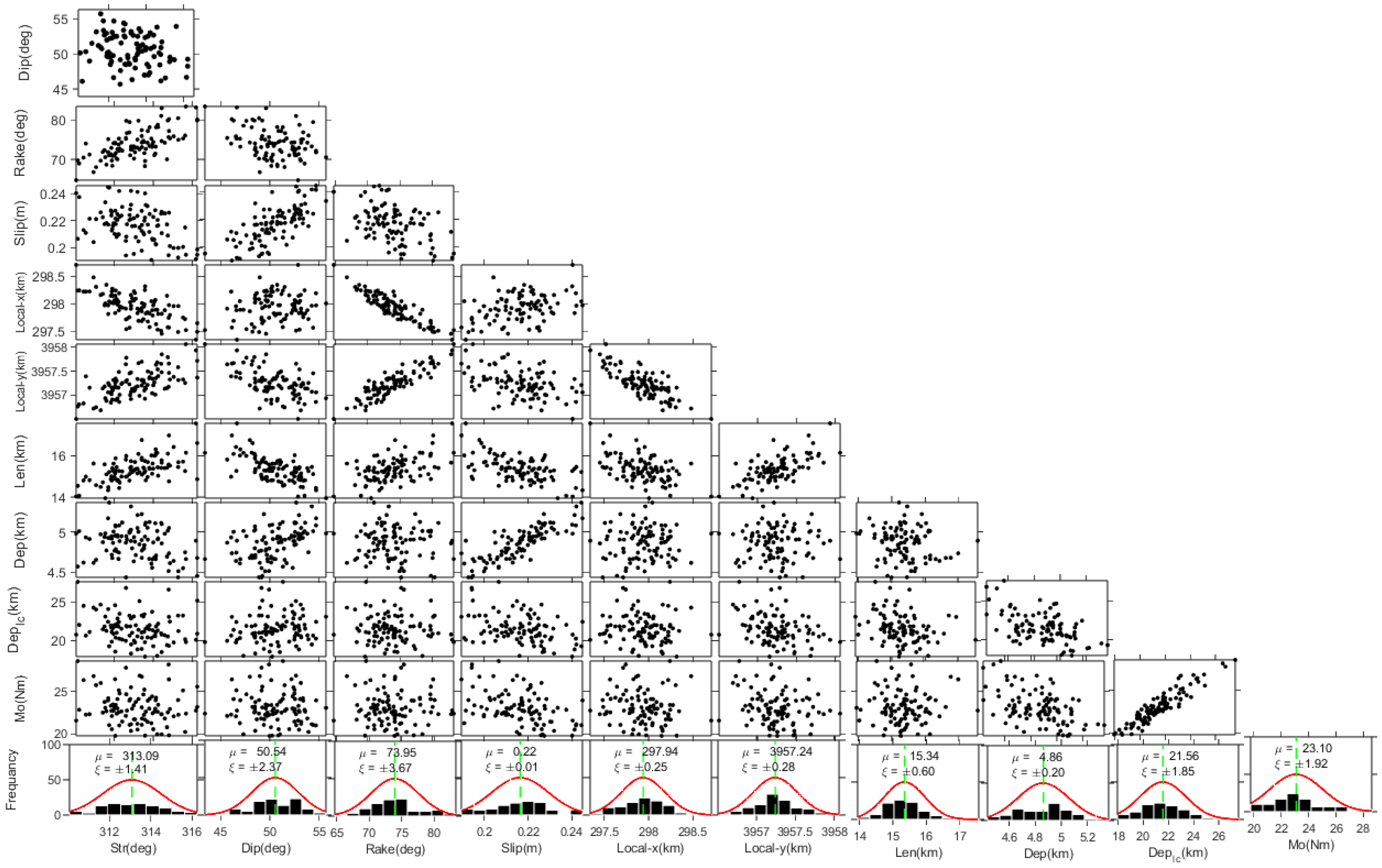
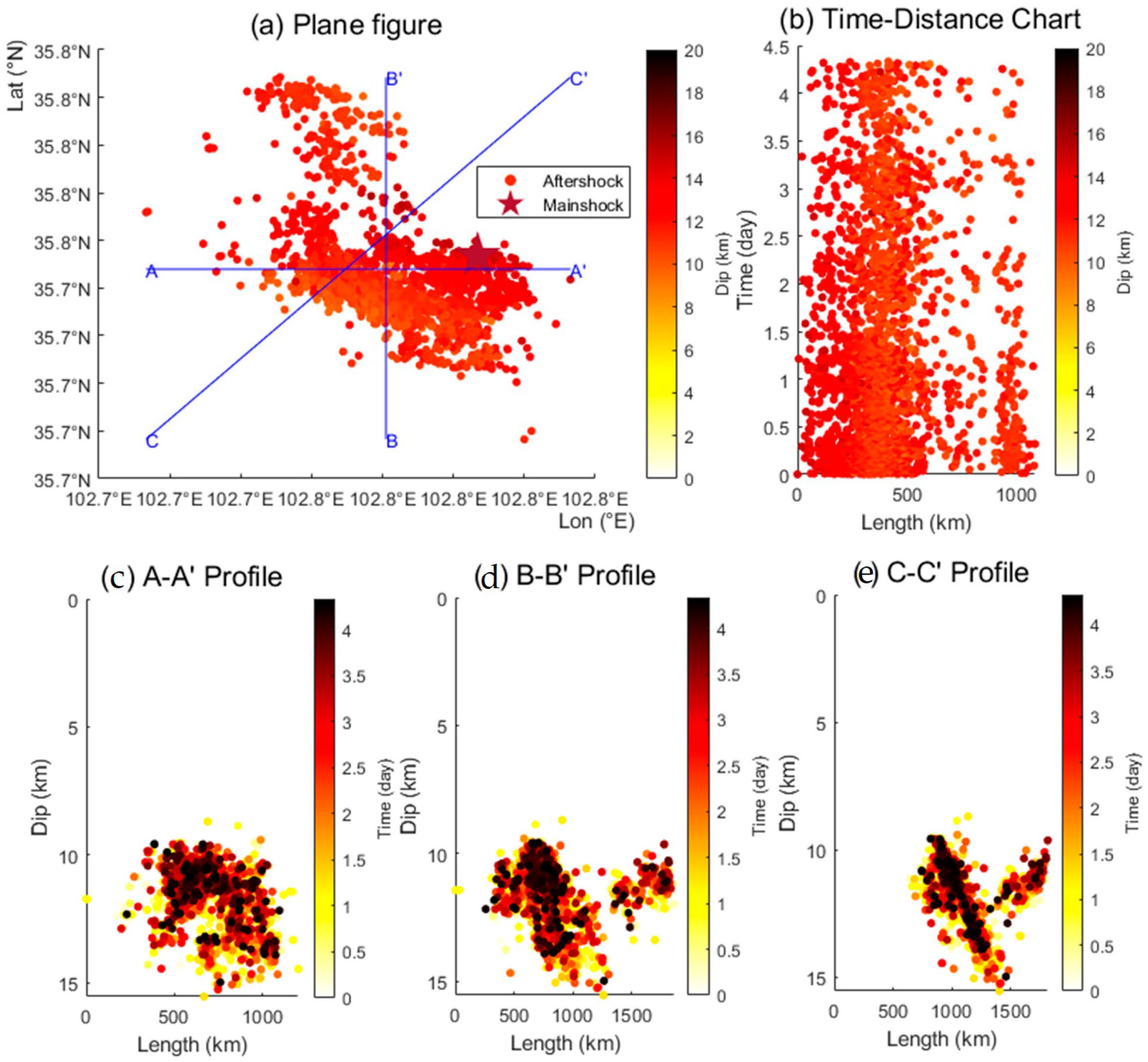

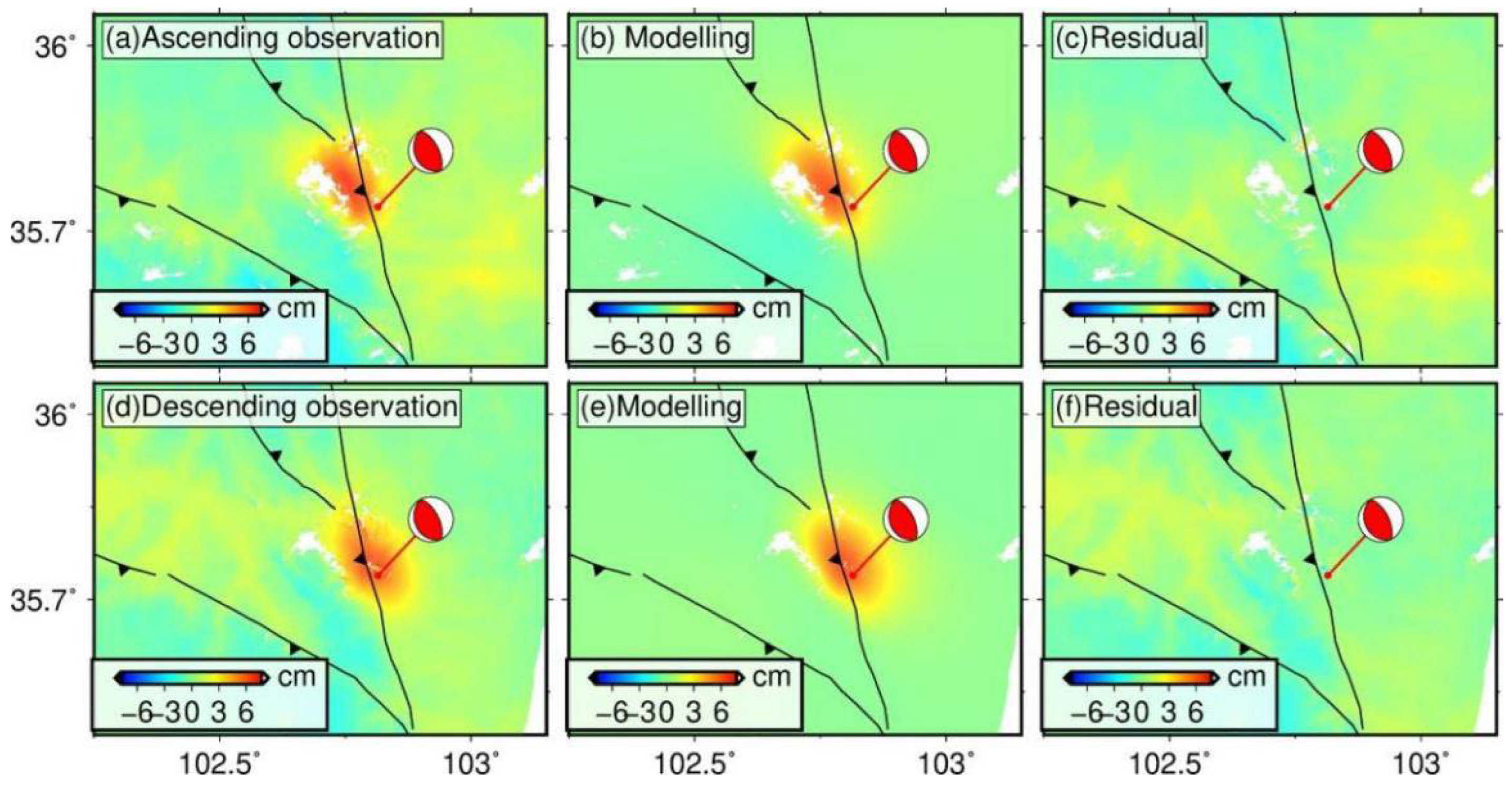

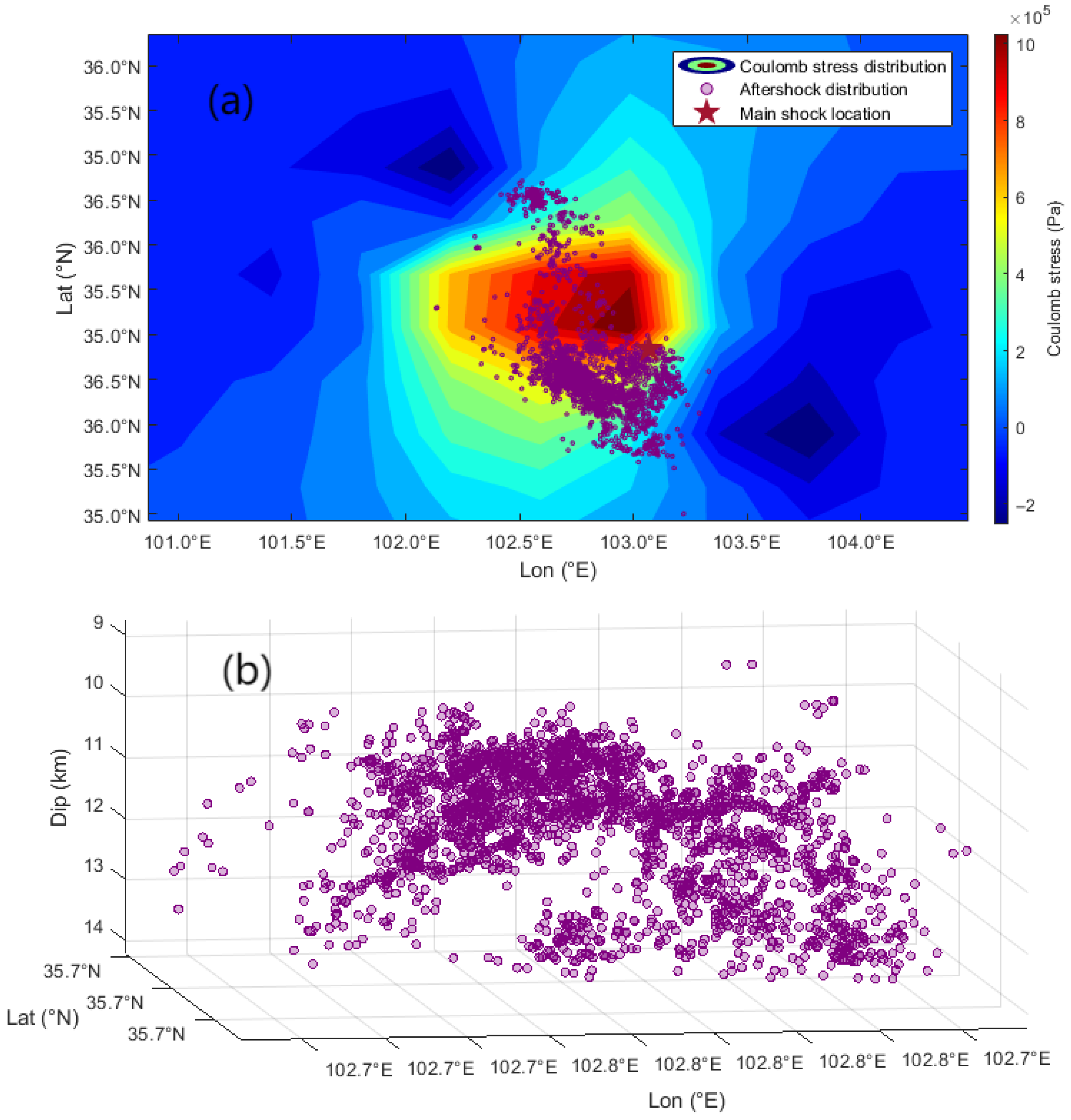
| Institution | Epicenter/(°) | Depth/km | Fault Plane 1/(°) | Fault Plane 2/(°) | MW | |||||
|---|---|---|---|---|---|---|---|---|---|---|
| E | N | Strike | Dip | Rake | Strike | Dip | Rake | |||
| USGS | 102.827 | 35.74 | 10 | 156 | 28 | 83 | 333 | 62 | 88 | 5.9 |
| GCMT | 102.810 | 35.83 | 18.9 | 164 | 46 | 122 | 303 | 52 | 62 | 6.1 |
| Liu et al. [2] | 102.750 | 35.76 | 9.3 | 143 | 38 | 104 | 319 | 43 | 104 | 6.1 |
| Yang et al. [3] | 102.377 | 35.96 | 9.0 | 169 | 43 | 125 | 305 | 56 | 61 | 6.0 |
| Yang et al. [4] | 102.730 | 35.71 | 6.6 | 149 | 34 | 116 | 311 | 54 | 80 | 6.1 |
| Fang et al. [7] | 102.760 | 35.77 | 7.7 | 120 | 61 | 77 | 325 | 32 | 112 | 6.0 |
| This study | 102.780 | 35.75 | 4.9 | 150 | 28 | 120 | 313 | 50 | 74 | 6.1 |
| Satellite | Track | Reference Date | Repeat Date |
|---|---|---|---|
| Sentinel-1A | Ascending track 128 | 27 October 2023 | 26 December 2023 |
| Sentinel-1A | Descending track 135 | 14 December 2023 | 26 December 2023 |
| ALOS-2 | Ascending track 146 | 12 August 2016 | 22 December 2023 |
Disclaimer/Publisher’s Note: The statements, opinions and data contained in all publications are solely those of the individual author(s) and contributor(s) and not of MDPI and/or the editor(s). MDPI and/or the editor(s) disclaim responsibility for any injury to people or property resulting from any ideas, methods, instructions or products referred to in the content. |
© 2025 by the authors. Licensee MDPI, Basel, Switzerland. This article is an open access article distributed under the terms and conditions of the Creative Commons Attribution (CC BY) license (https://creativecommons.org/licenses/by/4.0/).
Share and Cite
Ma, K.; Liu, Y.; Hu, Q.; Yang, J.; Wang, L. Fault Geometry and Slip Distribution of the 2023 Jishishan Earthquake Based on Sentinel-1A and ALOS-2 Data. Remote Sens. 2025, 17, 2310. https://doi.org/10.3390/rs17132310
Ma K, Liu Y, Hu Q, Yang J, Wang L. Fault Geometry and Slip Distribution of the 2023 Jishishan Earthquake Based on Sentinel-1A and ALOS-2 Data. Remote Sensing. 2025; 17(13):2310. https://doi.org/10.3390/rs17132310
Chicago/Turabian StyleMa, Kaifeng, Yang Liu, Qingfeng Hu, Jiuyuan Yang, and Limei Wang. 2025. "Fault Geometry and Slip Distribution of the 2023 Jishishan Earthquake Based on Sentinel-1A and ALOS-2 Data" Remote Sensing 17, no. 13: 2310. https://doi.org/10.3390/rs17132310
APA StyleMa, K., Liu, Y., Hu, Q., Yang, J., & Wang, L. (2025). Fault Geometry and Slip Distribution of the 2023 Jishishan Earthquake Based on Sentinel-1A and ALOS-2 Data. Remote Sensing, 17(13), 2310. https://doi.org/10.3390/rs17132310





